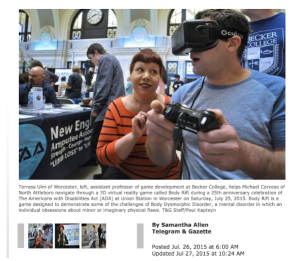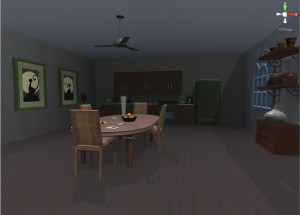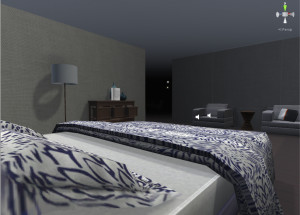The City of Worcester invited key community organizations to participate in this juried exhibition held in celebration of the American’s with Disabilities Act’s [ADA] 25th anniversary. Paul Cotnoir accepted the challenge, and the game department was very excited at the opportunity to develop and showcase in honor of the ADA. Professor Theinert and I knew we wanted our interactive piece to focus on promoting awareness, and while there were a number of physical and mental challenges we could have chosen to address, we specifically wanted to leverage the immersive and visual power of the Oculus Rift, VR headset. This design choice helped us to narrow our list, and upon further research, not only could we not find other VR experiences targeting Body Dysmorphic Disorder [BDD], but we also realized it would be a strong choice for the narrative approach we wished to pursue.
Mary-Lou Roberts, Assistant Director of the CLC was our content expert for the project. She also aided in design choices for the game and helped to develop the exhibit.. Further, she worked with Matthew Hopkins and Paul Cotnoir to develop a tri-board lecture poster for the event and volunteered to actually man the exhibit with us, fielding BDD questions. It was a wonderful experience working with Roberts. Obviously the exhibit would not have been possible without her, but furthermore, much of the value of the game experience was informed by her expertise.
We had a development time of 30 days, so we utilized a unique approach to asset design — I used a random character generator which I then scripted to create 10-20 variations of one main prototype for both male and female targets. For the main character’s apartment, we purchased free-licensed 3D assets from the Unity Asset Store which saved us hundreds of hours and yet allowed us to customize the textures and colors in order to flesh out a convincing living environment. I decided it was important however, to create personal assets such as photographs, journal notes, and artwork. As the sole programmer for the project, I created a timing system to accommodate a large, flowing audience at the exhibit space; a scripted audio mastering setup in Unity for the binaural sound; integration of the Oculus Rift hardware; integration of a gamepad controller for user input; and most importantly, a unique visual puzzle to represent the sense of Body Dysmorphic Disorder — never being able to truly see yourself as others do.
In VR I research various forms of input to address the unique challenges of the medium, and I am also particularly interested in the power of 3D audio, or binaural audio, in conjunction with virtual spaces. Working with David Gates, who volunteered his expertise as an audio engineer and his equipment for the project, I recorded binaural voice-overs representing the piercing, persistent, negative thoughts regarding a person’s physical appearance frequently suffered by those with BDD. Due to the nature of binaural audio, the player is able to actually feel as if a disembodied voice is coming directly from behind them, over her shoulder, or inside her ears. This audio element as well as the Rift, made the experience particularly immersive and therefore hopefully more compelling in its mission to help others empathize with those diagnosed with BDD.
We were covered on the Becker College website and the crew from Charter TV3 came to campus in order to interview us.
I was asked by Jeffrey Bail to be a Virtual Reality Panelist speaking on education and medical VR and providing a post-mortem for “Body Rift” at the Venture Cafe in Cambridge.
And finally, our exhibition as part of the ADA celebration in Worcester’s Union Station made the front page of the Telegram & Gazette.



